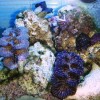Giant clams are a great choice that offers beauty, biological benefits and biological diversity. Proper lighting, water movement, trace elements and placement of the giant clams, will ensure the health of these fascinating invertebrates.
[google_adsense_in_post]
The clams of interest are of the genus Tridacna. These beautiful clams include T. maxima, T. crocea, T. squamosa and T. derasa. There is amazing variation in color and pattern within these species, some resembling living pieces of art, making Tridacna clams highly desirable
Benefits to your aquarium:
Besides their beauty, clams provide another important benefit to a saltwater aquarium: biological filtration. Their superior filtering capabilities offer added stability and nutrient control in a closed aquarium system. Excess nutrients lead to problems with low pH, algae and cyanobateria blooms – general poor water conditions that ultimately affect the health of all inhabitants within the aquarium.
Clams constantly filter nutrients such as ammonia and nitrate from the water thereby reducing the biological load and lowering the overall nitrate level in the aquarium, improving water conditions.
Environmental requirements:
Lighting:
Proper lighting is the most critical parameter essential to the well being of giant clams. Tridacna clams not only filter nutrients from the water to satisfy their dietary needs, but also employ algae cells within their mantie called zooxanthellae. These algae cells require light as well as nutrients from both the clam and the water to properly photosynthesize. The clam then utilizes the energy the algae cells produced through photosynthesis to aid in its growth.
Clams therefore require moderate to high lighting conditions, ideally supplied by power compact fluorescent fixtures or metal halide fixtures. If using fluorescent fixtures, simple place the clam closer to the light source.
Water movement:
Tridacna clams do not like strong, direct water currents. They prefer moderate, indirect water movement. Strong, direct water movements seems to inhibit the clam’s ability to adjust the amount of water passing through it, affecting their ability to properly filter the water.
Trace elements:
The three main trace elements that clams require are calcium, strontium, and iodine. These elements should be present in the aquarium at or near levels found in nature. Regular water changes and routine supplementation replenish these trace elements. However, if the aquarium is heavily stocked or if aggressive chemical filtration is used, more frequent supplementation may be necessary.
Placement:
Proper placement within your aquarium is the final aspect to consider when caring for Tridacna clams. After evaluating your lighting system and water movement within the aquarium, choose the proper location for your clam.
1. Place the clam so that the mantle is facing upward towards the light to maximize exposure to light. The mantle must be in full illumination in order to provide the clam with nutrients.
2. If a more powerful lighting system, like metal halides, are used on an aquarium 24 inches or less, these clams can be placed just about anywhere in the aquarium, as long as they are not blocked from the light.
3. If at any time clam moves and is lying on its side, right the clam back to the upright position. Do this immediately or the clam will slowly starve to death.
4. Do not place the clam in a crevice where it may have difficulty fully opening its shell. Make sure the location is sturdy and offers enough room for the clam to grow.
5. Do not place the clam in an area that has strong, direct water movement.






